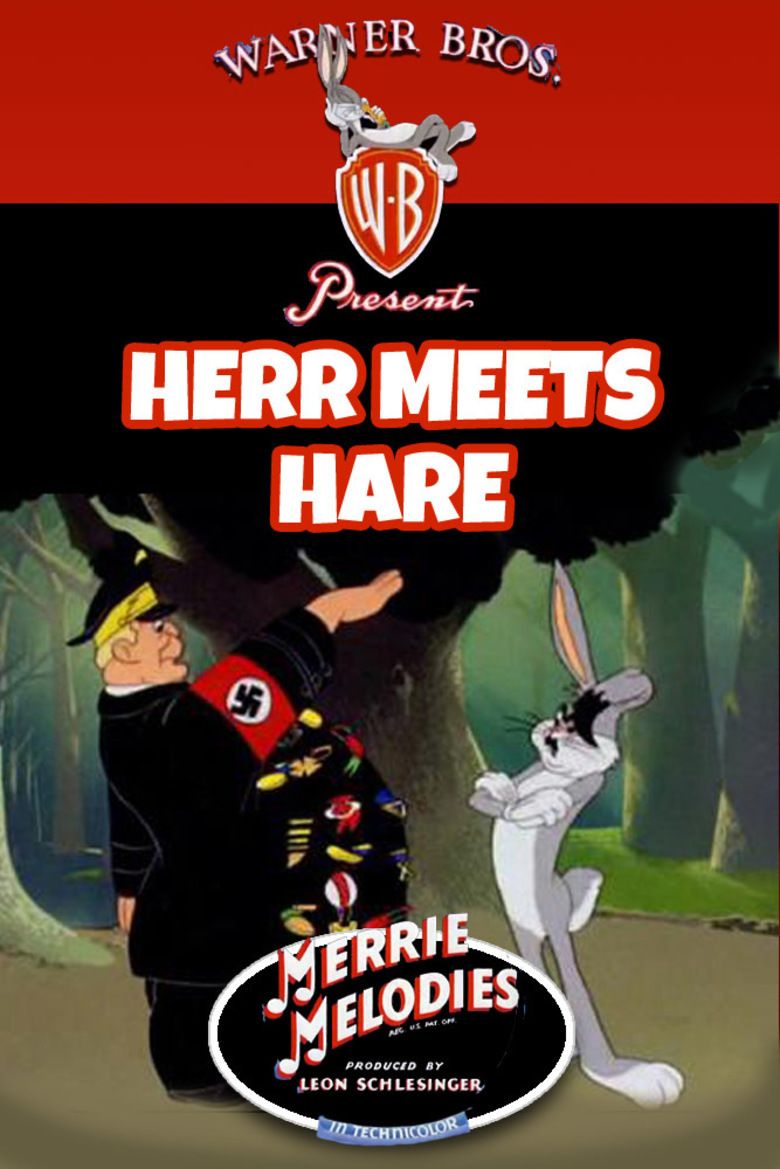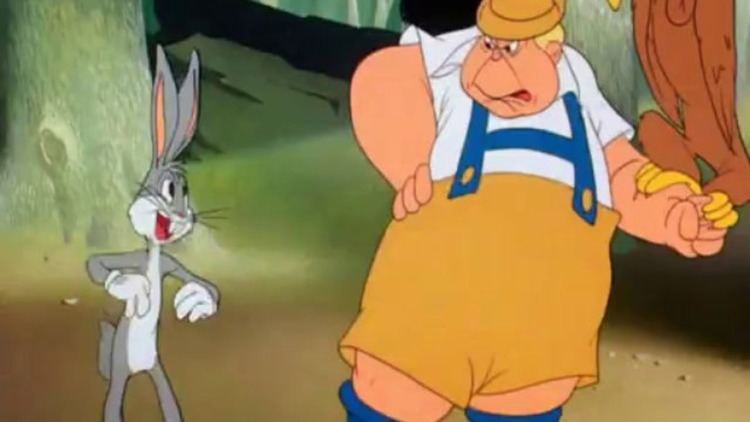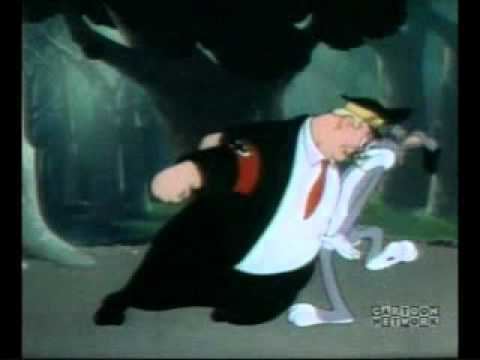Herr Meets Hare
7.4 /10 1 Votes
Music director Carl Stalling Language English | 7.2/10 IMDb Genre Family, Animation, Short Film series Merrie Melodies Duration | |||||||||||||||||||||||||||||||||
 | ||||||||||||||||||||||||||||||||||
Release date January 13, 1945 (United States) Similar movies Merrie Melodies movies, Related Friz Freleng movies | ||||||||||||||||||||||||||||||||||
Herr Meets Hare is a 1945 Warner Bros. cartoon directed by Friz Freleng, under the Merrie Melodies series. This short, coming a few months before the collapse of the Third Reich, was one of the last major wartime cartoons from Warner Bros. It was released 4 months and 17 days before Adolf Hitler committed suicide. Herr Meets Hare also sets up two important facets of Bugs Bunny: one in which Bugs would realize he "should have made a left toin [turn] at Albukoykee". The other is an extended dance sequence in the middle, which would later be retooled by Chuck Jones into What's Opera, Doc?.
Contents

Synopsis

The cartoon opens with a faux Walter Winchell-like voice discussing the end of the Third Reich, saying that "Germany has been battered into a fare-thee-well", and musing about where the high leadership, and "Fatso" Göring in particular has gone. The scene soon cuts to the Black Forest, where Hermann Göring—in bemedalled lederhosen—is "soothing his jangled nerves" marching while on a hunt. Nearby, a familiar furrow in the ground appears, with a hole at the end.

Bugs pops out of the hole, and sees no sign of the Black Forest on his map (variants of this scene would be used in later cartoons as the lead-in to the joke that Bugs, while tunneling underground, did indeed turn wrong somewhere in New Mexico, usually by not taking a left turn at Albuquerque. This cartoon is the first time Bugs says the popular catchphrase: "I KNEW I ‘shoulda’ (should have) made ‘dat’ (that) left ‘toin’ (turn) at ‘Albakoikie’ (Albuquerque)"). Bugs asks Göring about the directions to Las Vegas, oblivious to his location. Göring is almost tricked into going to Las Vegas, but then quickly realizes, "Las Veegas? Why, there is no Las Veegas in Germany!" before he fires his musket at Bugs. Genuinely alarmed by his mistaken destination ("Joimany?! Yipe!"), Bugs hightails it. Göring chases after the rabbit, trying to suck Bugs out of his hole with his musket as a plunger.

A few chase gags go by in which Bugs insults the integrity of Göring’s medals by bending one with his teeth. Suckered into bending one himself, Göring declares them ersatz and mumbles all sorts of anti-Hitler sentiments ("Oh, do I hate that Hitler swine, that phony führer, that…"). Bugs masquerades as Adolf Hitler using a bit of mud, and faces the surprised Göring. Göring disappears off-screen in a flash to change into his Nazi uniform adorned with all sorts of medals. After the usual Nazi salute, Bugs berates him in faux German as he rips all of the medals off Göring's uniform (Klooten-flooten-blooten-pooten-meirooten-tooten!), quickly followed by his belt. Göring "kisses" in reverence, saying, "Look! I kiss mein Führer’s hand. I kiss right in der Führer’s face!" (the joke being a wildly popular song at the time of the same name composed by Oliver Wallace, and performed by Spike Jones's band, and the subject of a rival short animated subject from the Walt Disney Company). Afterwards, Göring exclaims "Oh, I’m a bad flooten-boy-glooten!", a variant on Warner Bros. cartoons' frequently-cited Lou Costello-type catchphrase: "I'm a bad boy!".

Later, when the jig is up, Bugs rides in on a white horse, dressed as Brünhilde—from Wagnerian opera, to the tune of the "Pilgrims’ Chorus" from Tannhäuser). Entranced, Göring responds by dressing up as Siegfried. The two dance, before Bugs once again makes a fool of Göring and escapes (a scene later re-used in What's Opera, Doc?, co-starring Elmer Fudd).
Eventually, Göring gets a hawk to capture Bugs. Bugs, standing next to Göring asks, "Do you think he’ll catch me, doc?" to which Göring replies, "Do I think he'll catch you? Why, he’ll have you back here before you can say Schicklgruber." (Schicklgruber was the original surname of Hitler’s father Alois.) Bugs runs off and jumps into his rabbit hole, but as he falls down the hole, the hawk, which imitates Jimmy Durante, catches Bugs in a bag, capturing him. Göring brings the bag to Hitler, who plays solitaire in front of a map depicting the decline of Fortress Europe. Göring identifies the captive in the bag as "Bugsenheimer Bunny" (as opposed to "Weisenheimer", or "wise guy") to der Führer. As Herr Hitler talks of the great rewards he’s going to pile upon Göring for this act of heroism, he peeks inside the bag and is shocked ("Ach!! Himmel!"). Göring goes and looks inside the bag as well, to be shocked as well (again, "Ach!! Himmel!"). Out of the bag comes Bugs dressed as Joseph Stalin—complete with an enormous pipe and a large moustache—staring back at them. As the cartoon ends, Bugs glances back at the camera and asks, in a Russian accent: "Does your tobacco taste different lately?", citing an ad slogan of that era for the Sir Walter Raleigh pipe tobacco manufactured by the Brown & Williamson Tobacco Company.
Analysis
Bugs dresses as Hitler to assert control over his German opponent. This is a repetition of a scene from Bugs Bunny Nips the Nips, in which Bugs dresses up as a Japanese general.
Daniel Goldmark cites the cartoon as a significant precursor to What's Opera, Doc? (1957) and a source for its visual imagery. After running off, Bugs re-enters the scene dressed as Brünnhilde. The costume includes a blonde wig with braids and a Viking-style helmet. Bugs rides on a white horse, visually based on the Clydesdale horse. Musically, the scene is accompanied by the "Pilgrim’s Chorus" from the “Tannhäuser” (1845).
In response, Hermann Göring changes clothes. His lederhosen is replaced by a long brown loincloth. He wears a horned-type Viking helmet. The horns grow in size as if erect, as he lustfully gazes at "Brünnhilde". The duo dances to the tune of two waltzes by Johann Strauss II: "Vienna Life" and "You and You", the latter originating in Die Fledermaus (1874).
The entry of Bugs and his white horse into the scene is repeated in What’s Opera, Doc?. The dance with the male suitor is, however, changed from a slapstick-rendition of the waltz to a refined ballet. The motivation of the dancers also changes. Göring is "lost in the moment" and follows his partner's lead. In the latter, the dance is part of an artistic performance.
Both cartoons were written by Michael Maltese, which may account for the similarities. In the older short, the musical references were intended as a criticism of Germany, Richard Wagner serving as "a suitable musical backdrop". The second short makes Wagner and opera itself as its targets.
Reception
Like other American animated cartoons, Herr Meets Hare was available to German prisoners of war in the United States, some of whom did not like it; Hans Goebler said: "You saw Hermann Göring standing there full of decorations, then all of a sudden a rabbit showed up and took all the decorations off, and stuff like that. And we didn’t care for that."
As with many of the World War II–themed cartoons put out by the major studios, Herr Meets Hare was placed under an unofficial ban from broadcast or video distribution by Warner Bros. and other rights-holders (including Turner Broadcasting and AOL Time Warner). In 2001, Cartoon Network had planned on showing each and every Bugs Bunny cartoon made so far as part of its yearly "June Bugs" festival. AOL Time Warner refused to allow the broadcast of Herr Meets Hare, on the grounds that the cartoon was offensive (by today's standards) as it dealt with the Nazis in a joking manner.
The cartoon saw limited broadcast on a special one-hour episode of ToonHeads about cartoons from World War II. It has also appeared on Turner Classic Movies’ Cartoon Alley as recently as January 20, 2007.
Availability
References
Herr Meets Hare WikipediaHerr Meets Hare IMDb Herr Meets Hare themoviedb.org
